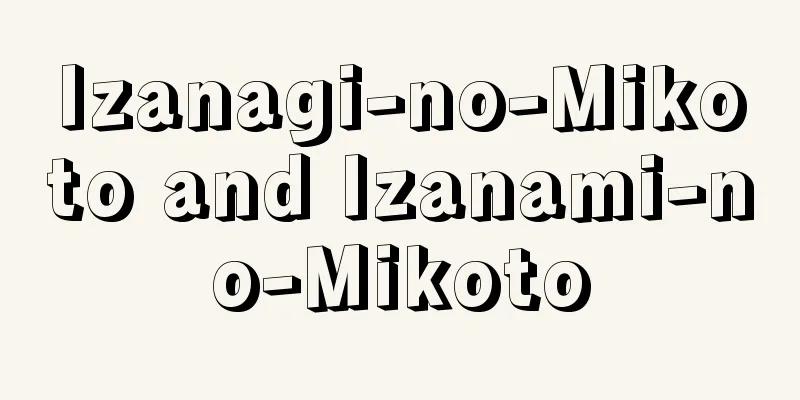Tales of Now and Then - Konjaku Monogatarishu

|
A collection of tales from the late Heian period. It contains 1,059 stories (19 of which are missing the main text) organized into 31 volumes (volumes 8, 18, and 21 are missing). [Masato Mori] EstablishedIt was probably written around the time of the Shirakawa Insei (the cloistered government of Emperor Shirakawa) sometime after 1120 (the 1st year of the Hoan era). The editor is unknown. There are differing opinions as to whether it was the work of several people working together under a central editor, or whether it was the work of one person. However, judging from the overall structure, materials, and style, it is likely that it was compiled by someone in the Buddhist world. It is believed that there were written sources for all the tales. The main reliable sources are the Chinese Buddhist tale collections "Sanbo Kan'yo Yayakuroku," "Meihoki," and "Guzan Hokke-den," as well as the Funabashi family's original "Koushi-den," and the Japanese "Nihon Ryōiki," "Sanbo E Kotoba," "Nihon Ojo Gokurakuki," "Hokke Genki," and "Toshiyori Zuinō." In addition, the Tale of the Grand Minister of Uji by Minamoto Takakuni, which is no longer in circulation, and several collections of Buddhist tales are also thought to have been important sources. In this way, this work compiles together the various lineages of tale collections that had been produced up until that point. [Masato Mori] Contents and FeaturesThe work is divided into three parts: volumes 1-5 are about Tenjiku (India), volumes 6-10 are about Sintan (China), and volumes 11-31 are about Honcho (Japan). Each part is divided into two chapters: Buddhism and secular. Each part and chapter classifies and arranges the stories according to their theme and material, and the whole is meticulously constructed. Each story is formally unified by the opening phrase "Ima wa mukashi" (now past) and the closing phrase "Tonamu ko ri den hetarutya" (now the words of Tonam). Also, the stories that tell of the origins are arranged in chronological order from the beginning of each part, so it is clear that there was a basic concept that shows the history of Buddhism and royal law in the three countries. In this way, this work was an attempt to portray the entire world as conceivable at the time through stories, and to give unity and order to all matters and events. It is thought that the concept was born out of the conscious and unconscious influence of the fluctuation in values and social stagnation of the late ancient period. The tales are set in a wide range of locations, from the central to the periphery, and the characters are diverse, from kings and nobles to men and women of all ages and backgrounds, as well as monsters and animals. While the editor is generally based on old values, he has taken up a new world that previous literature had not paid attention to, and in particular he has concretely depicted the spirit and actions of saints who practiced asceticism in the forests and spread Christianity among the people, samurai, and thieves. Therefore, the literary spirit is ancient, and at the same time, the work foreshadows the beginnings of medieval literature. Furthermore, although the materialistic style, which mixes kanji and katakana, was not suitable for expressing lyricism or the subtle inner thoughts of humans, it is quite effective when dealing with non-traditional, non-aristocratic subjects. It is considered a precursor to Japanese-Chinese hybrid writing, such as in "The Tale of the Heike." [Masato Mori] ImpactMost of the extant copies were handwritten in the Edo period, and all of them have their origins in the Suzuka version from no later than the mid-Kamakura period, so it seems that it was hardly circulated in the Middle Ages. There is no evidence that it had a direct influence on medieval literature. Parts of the secular section of the Honcho section were published in the Edo period. In modern times, Akutagawa Ryunosuke used the tale as material for his novels such as "Rashomon" and "Imogayu," and it was around this time that its literary value finally began to be noticed. [Masato Mori] "The Complete Collection of Japanese Classical Literature 22-26 Konjaku Monogatarishu 1-5, edited by Yamada Takao et al. (1959-63, Iwanami Shoten)" ▽ "The Complete Collection of Japanese Classical Literature 21-24 Konjaku Monogatarishu 1-4, edited and translated by Mabuchi Kazuo et al. (1971-76, Shogakukan)" ▽ "Japanese Literature Research Materials Series Konjaku Monogatarishu" (1970, Yuseido Publishing)" ▽ "The World of Konjaku Monogatari, by Sakaguchi Tsutomu (Kyouikusha Rekishi Shinsho)" ▽ "The World of Konjaku Monogatarishu: The Dawn of the Middle Ages, by Ikegami Jun'ichi (1983, Chikuma Shobo)" Source: Shogakukan Encyclopedia Nipponica About Encyclopedia Nipponica Information | Legend |
|
平安後期の説話集。1059話(うち本文を欠くもの19話)を31巻(うち巻8、18、21は欠)に編成する。 [森 正人] 成立1120年(保安1)以降まもなく、白河(しらかわ)院政のころ成るか。編者未詳。中心的編者のもとで複数の人の協同作業であったか、1人の手に成ったかについても、説は分かれている。ただ、構成、素材、文体などを総合的に判断して、仏教界に属する者の編であろう。すべての説話に文献資料があったとみられる。中国の仏教説話集『三宝(さんぼう)感応要略録』『冥報記(めいほうき)』『弘賛法華伝(ぐざんほっけでん)』および船橋家本系『孝子伝』、日本の『日本霊異記(りょういき)』『三宝絵詞(さんぼうえことば)』『日本往生極楽記』『本朝法華験記(ほっけげんき)』『俊頼髄脳(としよりずいのう)』が主要な確実な資料である。また、現在伝わらない源隆国(たかくに)作の『宇治大納言(うじだいなごん)物語』や、いくつかの仏教説話集も有力な資料となったと考えられる。こうして、本書は、それまでの説話集のさまざまの系統を集大成するものとなっている。 [森 正人] 内容・特徴巻1~5を天竺(てんじく)(インド)、巻6~10を震旦(しんたん)(中国)、巻11~31を本朝(日本)のごとく3部に分け、各部をそれぞれ仏法、世俗の2篇(へん)に分ける。各部、篇は、主題、素材によって説話を分類配列し、全体が緻密(ちみつ)に構成されている。各説話は、「今ハ昔」の冒頭句、「トナム語リ伝ヘタルトヤ」の末尾句をもって、形式的統一が図られている。また、各部冒頭から、創始を語る説話が年代順に配列されているから、3国の仏法と王法の歴史を示す基本構想のあったことが認められる。こうして本書は、当時考えられる全世界を説話によって描き出し、すべての事柄とできごとに統一と秩序を与えようとする試みであった。その構想は、古代末期の価値観の動揺、社会的行き詰まりが、意識的にも無意識的にも影響して生まれたと考えられる。説話の舞台は中央から辺境に及び、登場人物も国王や貴族から下層の老若男女、妖怪(ようかい)、動物と多様である。編者はおおむね旧(ふる)い価値観にたちながらも、従来の文学が目を向けることのなかった新しい世界を取り上げ、とくに、山林修行民間布教の聖(ひじり)、武士、盗賊などの精神と行動を具体的に描き出している。したがって、その文学精神は古代的であると同時に、中世文学の出発を予感させる作品ともなっている。また、即物的な漢字片仮名交じり文体は、叙情や人間の微妙な内面を表現するには適していなかったけれども、非伝統的、非貴族的な対象に対しては十分効果を発揮している。『平家物語』などの和漢混交文の先駆とみなされる。 [森 正人] 影響伝本のほとんどが江戸時代の書写で、それらはすべて、鎌倉時代中期を下らない鈴鹿(すずか)本を祖本とするから、中世にはほとんど流布しなかったらしい。中世文学に直接的な影響を与えた形跡もない。江戸時代に本朝部世俗篇の一部が刊行されている。近代に入って、芥川龍之介(あくたがわりゅうのすけ)がその説話を素材に『羅生門(らしょうもん)』『芋粥(いもがゆ)』などの小説を書き、そのころからようやく文学的価値が注目されるようになった。 [森 正人] 『山田孝雄他校注『日本古典文学大系22~26 今昔物語集1~5』(1959~63・岩波書店)』▽『馬淵和夫他校注・訳『日本古典文学全集21~24 今昔物語集1~4』(1971~76・小学館)』▽『『日本文学研究資料叢書 今昔物語集』(1970・有精堂出版)』▽『坂口勉著『今昔物語の世界』(教育社歴史新書)』▽『池上洵一著『今昔物語集の世界 中世のあけぼの』(1983・筑摩書房)』 出典 小学館 日本大百科全書(ニッポニカ)日本大百科全書(ニッポニカ)について 情報 | 凡例 |
>>: Gonja Kingdom - Gonja Kingdom
Recommend
Hitting pattern - Uchie
〘Noun〙 In order to prevent the handles of spears, ...
Rudé, G. (English spelling) RudeG
...However, the anomie of the crowd (loss of norm...
《Arrowsmith》 - Arrowsmith
...In "High Street," an idealistic youn...
Memorial Hall - Kinendo
…Christian architecture consists of churches (cat...
Iwaki Glass Factory
…In 1917, Mitsubishi Limited Partnership Company&...
Semi-Automatic Ground Environment
…Abbreviation for Semi-Automatic Ground Environme...
Asparagopsis taxiformis (English name) Asparagopsistaxiformis
…It is known to be distributed in northern Europe...
International Relations
The study of the relationships between states, and...
Austrian briar (English spelling)
…2 n = 14, 21, 28. (2) Rosa foetida Herrm. (= R. ...
Isinglass - Isinglass (English spelling)
A type of fish glue. It has long been made in Eur...
Orvieto Cathedral - Orvieto Cathedral (English name) Duomo Orvieto
Orvieto, a city in central Italy, is a cathedral o...
Consumption and household statistics
The economic activities of households, such as ear...
William IV - William
…In the first half of the 16th century, the eldes...
Sarutahiko no Okami - The Wolf of Sarutahiko
The name of a god who appears in the Kojiki and Ni...
Gardoni G. - Gardoni
…Furthermore, Molnár, a writer of urbanism, achie...









